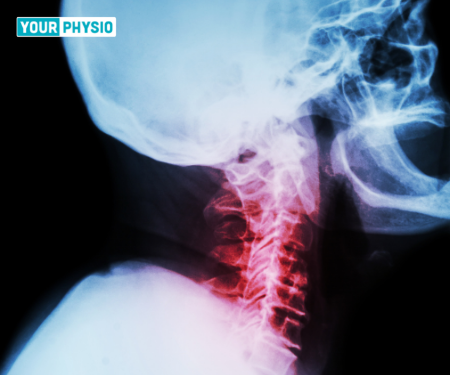INTRODUCTION
Cervical spondylosis includes a wide range of degenerative changes of the spine. It is also known as arthritis of the neck or osteoarthritis of the neck.
The spine is made up of the vertebrae, facet joints, intervertebral discs, lamina and the ligamentum flavum. This condition is known to cause pain and stiffness in the neck. Most commonly seen in individuals over 50-60 years of age.
Chronic degeneration starts reflecting in the intervertebral discs and facet joints. Which may further lead to disc herniation, osteophyte formation and compression of the spinal cord.
A herniation or compression can touch the cartilage or ligament surrounding the spine. Eroding the cartilage further. An eroded cartilage thus causes pain during neck movements and neck stiffness.
RISK FACTORS
Elderly population, mostly after the age of 50, are prone to this condition.
Chronic history of cigarette smoking
Occupational history of prolonged neck strain.
Having a past neck injury
Heavy lifting work like construction labourers
Exposure to vibration like for truck drivers.
SYMPTOMS
Most cases are commonly asymptomatic. A person above 30 years may show degenerative changes in his scans but not have any symptoms.
However, some common symptoms of Cervical Spondylosis include:
Neck pain or stiffness. This might be the fundamental indication. The pain might reduce on moving the neck
Diffuse pain in the neck. A pain that cannot be localised to a specific point may be felt.
Muscle spasms seen in the neck region or shoulder.
A characteristic sound on moving the neck. A clicking or popping sound may be heard.
Dizziness
Headaches usually radiate to the neck.
Neck pain or numbness radiating to arms, hands or fingers. This pain is due to compression of a nerve root in the cervical region. Also known as cervical radiculopathy.
Balance impairment
Trouble during walking or maintaining a walking posture.
HOW TO DIAGNOSE CERVICAL SPONDYLOSIS?
The signs and symptoms of cervical spondylosis along with diagnostic scans are useful in diagnosing cervical spondylosis. Neck pain, neck stiffness, tenderness on palpation, referred pain to arms or fingers are classic signs of cervical spondylosis.
Most patients don't require further examination and the analysis is made on clinical grounds alone. However, an X-ray, CT, MRI, and EMG can be utilised to affirm a diagnosis.
Plain radiographs of the cervical spine might show a deficiency of typical cervical lordosis. Lordosis can cause the muscles of the back to contract and some muscles to be in the lengthened position for a prolonged time. This can further lead to muscle spasms.
It is critical to understand that radiological changes with age just address underlying changes in the vertebrae, such changes don't really cause manifestations.
X-ray of the cervical spine is the commonest examination of decision. An X-ray gives a picture of the alignment of vertebrae or bone.
An MRI can assist in recognizing the specific area of pain. Especially if the manifestations are brought about by harm to delicate tissues, like a swelling or herniated disc or compression of nerves.
A Myelogram. In this imaging methodology, contrast colour is infused into the spinal cord. This is done to make the spinal column and nerve roots more prominent.
Electromyography (EMG) and Nerve conduction studies are frequently done alongside EMG to decide whether a spinal nerve is working appropriately.
TREATMENT
Medical Management
The treatment technique for cervical spondylosis relies upon the seriousness of a patient's signs and manifestations. Non-surgical treatment for cervical spondylosis is always a preferred choice. It involves a four-to six-week course of physical therapy.
Pharmacologic drugs, including nonsteroidal anti-inflammatory drugs (NSAIDs), oral steroids, muscle relaxants, anticonvulsants, and antidepressants are given. They are primarily to reduce pain and discomfort.
Momentary utilisation of a delicate cervical collar can help reduce intense neck pain. This cervical collar even assists in maintaining the normal cervical lordosis of the spine. However, using the cervical collar for a long period of time can cause harm. As it keeps the neck in a fixed position, the muscles of the neck may undergo tightness or spasms and cause pain even on the slightest of movement.
Surgical Management
For the most serious instances of cervical spondylosis - including cervical myelopathy or cervical radiculopathy - your medical services suppliers might think about a medical procedure.
Decompression and relieving of structures due to compression of the nerves is the main aim here.
Physiotherapy Management
Treatment ought to be individualised. Yet, by and large it incorporates exercises, proprioceptive retraining, manual treatment and postural re-education.
Neck, shoulder and upper arm pain can be treated with trigger point release. It can be utilised to treat myofascial trigger points in the muscles.
Mobility exercises of the thoracic spine can be used to decrease pain and increase mobility of the spine.
Postural education incorporating the arrangement of the spine during sitting and standing activities is taught.
Home Exercises are taught to patients to learn about the different movements that reduce pain and increase mobility of the cervical region. These home exercises involve neck isometrics and strengthening exercises.
PREVENTION
It is highly unlikely to prevent cervical spondylosis altogether. However, we can reduce the occurrence of symptoms by dong the following:
Being physically active. Maintaining a minimum of 30 minutes workout 3-4 times a week.
Utilising proper neck posture while sitting, standing.
Avoiding injury to the neck during heavy activities like playing sports,driving etc.
CONCLUSION
Cervical spondylosis has a characteristic course of maturing with age. It has a 95% occurrence by the age of 65 years. Cervical spondylosis is the most widely recognized spine pathology in older individuals.
A great many people stay asymptomatic until trauma or age advances further. The manifestations can rely upon the phase of the pathologic cycle and the site of neural pressure.
Moderate treatment can be started for patients with mild pain. This includes NSAIDs and physical therapy. Patients with unbearable neck pain, cervical radiculopathy, or cervical myelopathy are suggested both cnservative as well as surgical treatment options.

Illustrations designed by freepik